
MAY CONTAIN NUTS

Search Shorpy
SHORPY ART

Framed or unframed, desk size to sofa size, printed by us in Arizona and Alabama since 2007. Explore now.
Join and Share
Ad-Free Shorpy
Shorpy is funded by you. Patreon contributors get an ad-free experience.
Learn more.

Recent comments
- Recent view
- Hudson’s Big Store
- Say what??
- Grapes?!
- A Beautiful Moment
- Such joy
- Bethune-Cookman University today...
- Yellow sky at morning
- Side Winder
- Air Quality?
- Sojourner Truth riot
- None were so blind(ed)
- The less famous sister
- Good ol' days?
- Rise and Fall
- Goo Goo Ga Joob
- Ticket Retention
- Not the only one
- Vagaries of War
- Killed by Amtrak
- Back to the Future
- Wanted --
- If you can't stand the light
- Centralized Traffic Control, I believe
- What's really happening
- Heckuva remote control!
- Sometimes — Things Go Bump!
- I SEE THE LIGHT
- Union Switch and Signal Company
- Get That Light Out Of My Eyes
Member Photos
The Shorpy
Print Emporium
Print Emporium
Search Shorpy
Search results -- 30 results per page
- Edelweiss Cafe: 1912
- Detroit, Michigan, circa 1912. "Glaser's Edelweiss Cafe, Miami Avenue." 8x10 inch dry plate glass ... View full size.
Motor City Interesting photo. 1912 and there are four cars and no horses (or horse droppings) in the shot. I ... Posted by Dave - 08/14/2012 - 8:28pm -
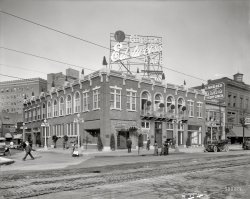
- High Roller: 1912
- Washington, D.C., 1912. "Borah, William E., Mrs., wife of Senator from Idaho." In a spiffy ... Posted by Dave - 08/28/2012 - 10:15pm -
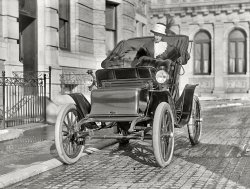
- Hotel McAlpin: 1912
- New York circa 1912. "Hotel McAlpin, Herald Square." 1,500 rooms with, the sign informs, ... Posted by Dave - 08/01/2012 - 5:45pm -
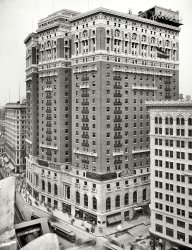
- Pringle Furniture: 1912
- Detroit, Michigan, circa 1912. "Pringle Furniture Co. showroom with tables and miscellaneous furniture." ... Posted by Dave - 08/08/2012 - 3:11pm -
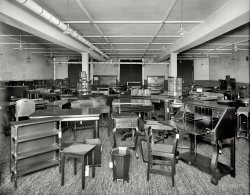
- If I Wore a Bell: 1912
- ... incredible hat. Another photo from the collection of circa 1912 negatives I recently purchased. View full size.
Posthumous ... Posted by 3dfoto - 10/29/2016 - 10:45am -
![If I Wore a Bell: 1912 Our lovely lady from upstate New York once again, here wearing the most incredible hat. Another photo from the collection of circa 1912 negatives I recently purchased. View full size.
Posthumous modeling careerI am enjoying the pictures of this very fashionable lady. I wonder what she would have thought, had she known she was going to become a fashion model, a century later!
Very StylishI love how the trim on her coat matches her dress. I'll bet the stripes on her dress match the color of her coat.
It must be later in the season to need spats.
Wedding ring etiquetteWas it a custom of the day for a woman to wear only a diamond ring when she got married? I have noticed in a couple of these photos that she is wearing only a diamond ring.
A nice high collar.It was probably needed to keep one's neck from snapping under the weight.
Big Volume, Little MassThe lady's hat was huge but probably not at all heavy. Close examination of the embiggened photo reveals the thinness of the hat mesh fabric where the light shines through it above her left shoulder. The fabric on this model was probably a purpose-woven milliner's buckram, stiff but not stout, and even with its creped silk ribbon trims the hat probably weighed only a few ounces. The three-pronged fork shape protruding above the brim over her right shoulder is the ornamental end of her long front hatpin that secured the hat into the crown of her hair and prevented the hat from sailing up and away in the slightest breeze.
Ready for rainShe's prepared for bad weather. With a hat like that you don't need an umbrella.
Upstate New York womanThis woman bears a strong resemblance to members of the Roosevelt families...those of Teddy and FDR. Perhaps some of the photos were taken in Hyde Park.
Matchy-matchyI look forward to seeing more photos of this smartly dressed woman. I love the fact that the lining of her coat matches her dress. She was either quite well off or herself a dressmaker.
Analog AnnieCould that be called a breast watch?
[Lapel watch. -tterrace]
BuckramWhat a treat to have the extraordinary pictures of this woman from 3dfoto and to read all the comments on clothing and hats and rings and the timepiece, many of them written by men. We come to Shorpy for the photographs but we're also rewarded with words: e.g. willc's "a purpose-woven milliner's buckram, stiff but not stout" -- pure poetry!
Pocket? Is that horizontal blur above the watch a pocket opening?
On a side note, I did a stint as a model for a while in my youth, and there were always certain designs that we called 'statue clothes' that looked great as long as you stood in the same position the designer drew them, but as soon as you moved they started to hurt. That's what I see in the clothes she is wearing.
I don't intend this comment as any sort of judgement, as at the time time women had two purposes, To look good in public, and maintain the home. It is impossible to use modern standards to judge.
Upstate New York WomanI'm glad that so many people are enjoying these photos. She looks like some I would have liked to have known. The comment about the Roosevelt likeness is interesting because in one of the photos she is laughing and, to me, resembles Eleanor. I believe her husband took most of the photos, since she seems so comfortable with the camera, and in some shots, she is clearly flirting a little. I have well over 100 negatives, and would like to post a few more, if only to cover some of the other outfits she has, if it's okay with Dave.
I saw the smileAnd it was the most sincere of her off guard moments when she was washing clothes. How her husband sneaked the camera into the wash room, I will never know. Anyway, her smile is as beautiful as she is.
Lapel watchI can remember even back in the early 1970s, my mother had a watch similar to that. And she was only in her 50s at that time.
re: Pocket?The item from which the lapel watch hangs appears to be a chatelaine. This is a brooch with multiple fine chains to which a woman could attach various useful items like needle-cases, scissors, watches and keys to keep them close to hand. They were quite common from the middle ages up through the beginning of the 20th century. By WWII they'd mostly fallen out of favor as women were carrying handbags or even wearing trousers with pockets [ gasp! ;-) ]
(ShorpyBlog, Member Gallery)](https://www.shorpy.com/files/images/img512_0.thumbnail.jpg)
- For Love of the Game: 1912
- 1912. "Football, Costello; Georgetown-Virginia game." Costello seems to be ... to allow for two-minute exposures. But 60 years later in 1912, improved emulsions allowed for shutter speeds of hundredths of a second ... in the Virginia football media guide. Georgetown won the 1912 game at home by a score of 16-13.
Georgetown and Virginia played 16 ... Posted by Dave - 08/04/2012 - 4:32am -
![For Love of the Game: 1912 1912. "Football, Costello; Georgetown-Virginia game." Costello seems to be having a pretty good time. Harris & Ewing Collection glass negative. View full size.
Technical AchievementThis is a wonderful example of a stop-action photograph, made in an era when such things were generally thought impossible to do. Before the 1930s, photo emulsions -- the light sensitive chemistry applied to glass plates or film -- were 'slow', meaning that you either had to have enormously high light levels or your subject had to remain relatively still. Compounding the problem were lens optics that were not terribly efficient at gathering up what light was available. Yet, here we have a photo that shows very little blurring and is on a par with that seen in Sports Illustrated. Kudos!
[That's a perception maybe encouraged by historical accounts of daguerreotype studios using neck braces on portrait-sitters to allow for two-minute exposures. But 60 years later in 1912, improved emulsions allowed for shutter speeds of hundredths of a second even on inexpensive cameras. There are hundreds of stop-action sports photos from the 1910s and 20s in the LOC archive, mainly the National Photo and Bain collections. Below, another photo from the Georgetown game. These were made using 5x7 plates. I think probably the most challenging part of photography like this would have been bulk -- the heavy camera, and glass-plate boxes that weighed 5 or 10 pounds -- and what must have been the cumbersome process of changing the plates for each exposure. It would be interesting to see an account of what that was like. - Dave]
ComicalThat's a good shot of Charlie Brown — where's Lucy?
Rubber or Metal?Please tell me that those cleats are made out of rubber?! Can you imagine being run over by those cleats if they were made out of metal?
Who Knew?They used to do overhead bicycle kicks in American Football?
Final ScoreI looked up this game in the Virginia football media guide. Georgetown won the 1912 game at home by a score of 16-13.
Georgetown and Virginia played 16 times between 1889 and 1913. The final record was 7 wins, 7 losses and 2 ties.
(The Gallery, Harris + Ewing, Sports)](https://www.shorpy.com/files/images/01677a.thumbnail.jpg)
- Oyster Shuckers: 1912
- February 1912. Port Royal, South Carolina. "Bertha, one of the six-year old shuckers at ... Posted by Dave - 02/01/2008 - 8:44pm -
![Oyster Shuckers: 1912 February 1912. Port Royal, South Carolina. "Bertha, one of the six-year old shuckers at Maggioni Canning Company. Began work at 4 a.m." View full size. Photograph (glass negative) and caption by Lewis Wickes Hine.
Wow.This one really got to me. I have such an easy life.
BerthaPeople who go on and on about the "good ol' days" should reflect. So haunting, even more so than the other shucker photos. Six. Years. Old.
So SadAnd the kids today think they have it tough. This photo makes want to cry.
Oyster shuckersI've seen a little of the so-called third world. While the United States has pockets of abject misery, most of those we consider poor here have a standard of living light years ahead of the rest of the world.
"Back in the day" almost everyone worked long hours, with little rest or diversion. It was considered normal. I'm glad most of our children now have the luxury of enjoying life. Some of them, though, could stand the discipline and rigor of a little more responsibility. Perhaps a little less than what is pictured here.
Flower GirlI find it so poignant that the little girl has a flower in her hair, it is probably the only way she can identify herself as a girl. If you didn't see her head you would assume she were a little boy. I wish I could wrap her in pink.
Unkonwing childrenAs I look at your pictures, I fear for the younger generation. I am a great-grandmother of 5 and my grandchildren don't know how to cook unless it comes from a box. When things got tough, I knew how to make soap and washed clothes on a washboard. (Washing machine broke down.) No money to fix or buy another one for quite a while. No, I didn't live in "the hills." I lived in Kansas City, Missouri, and was in my early 30s. I have a college education, and know how to do what has to been done. The young people of today haven't a clue in regard to what to do if the lights go out and the heat goes off or what is edible or medicinal in regard to plants. Our children, grandchildren, great-grandchildren haven't a clue. Frankly, past years had their faults, but if the electricity goes off or the "boxes" disappear from the shelves, we are in a world of hurt.
[When I was in grade school, we lived next door to the Unkonwings! - Dave]
Hard TimesI surely agree with your statement, I live on the other end of the state from you and do know what it is like to eat rabbit because I saw one out side my window one early morning when I was in a poor financial situation. I dread the future for the so many who do not know ow to provide for them selves. I am truly glad that my grand daughter or my children do not have to work this hard, but do fear we are going to see these times again way to soon.
(The Gallery, Kids, Lewis Hine)](https://www.shorpy.com/files/images/05331u_0.thumbnail.jpg)
- One-Ninety: 1912
- Wyandotte, Michigan, circa 1912. "Detroit Ship Building Co. Steamer No. 190, main engine in shop, ... Posted by Dave - 03/09/2018 - 12:13pm -
![One-Ninety: 1912 Wyandotte, Michigan, circa 1912. "Detroit Ship Building Co. Steamer No. 190, main engine in shop, three-cylinder compound-inclined type, (66 x 66 x 96) / 108 inches." 8x10 inch glass negative, Detroit Publishing Company. View full size.
Cylinder supportsThose crosses in the open ends of the cylinders are keeping them from collapsing. How they made those cylinders back then is beyond me, although the trolley crane gives some hints as to what was possible back then, and how heavily stuff was built.
SeeandbeeDSB hull number 190 was the sidewheel excursion steamer Seeandbee, launched in 1913. She later became the training aircraft carrier USS Wolverine, IX-64, operating out of Great Lakes Naval Training Center in Chicago. Many of her aircraft are scattered on the bottom of Lake Michigan.
My first guess was City Of Detroit III, but her hull number was 187.
The URL for the BGSU search page is:
http://ul.bgsu.edu/cgi-bin/xvsl2.cgi
I can waste almost as much time on that site as I do on Shorpy.
Working for a LivingAnd not afraid to get their hands, and clothes, dirty!
I see the problemThere's a small marsupial stuck in the pump housing.
Safety first?Not one pair of safety goggles or an OSHA inspector to be seen. Despite that they all look serious enough to take their personal safety into account.
I used to live in Wyandotte, circa 1987
Cylinder supports:Looking closely at those cross supports you'll note the small hole in the center of the cross and a pulley just below it. A thin wire is used with this arrangement and passes through the hole at the cylinder top end and where the piston rod runs through; to another device of this type at the crank-end. A heavy weight is used to draw the wire taught. Measurements are then made to assure cylinder bore, rod and crank centers are dead in alignment as well as the wires being perfectly parallel to each other in all axis'.
Shopwork!As a retired millwright I love the insights as to how things were built back then. Not a single hand held powertool in sight, yet look what they're building.Those crosses set up in the front of the cylinders are to to keep the bore true while they wait piston installation.So much activity going on here makes me wish I was there!
One at a TimeIt's possible to recognize some of the pieces shown here. That the engine is "3 cylinder compound" is evident. One high pressure (small) cylinder exhausts into the two larger low pressure cylinders shown behind the row of workers. (Note the class distinction: engineers wear a tie and white shirt; technicians and mechanics wear colored shirts and overalls. No one seems to be wearing a hard hat). You can see a crosshead at the left. The big pin takes the top end of the connecting rod and the guides constrain it to up and down motion only. this allows the bottom of the cylinder to have only a small hole (see it at the back end of each cylinder?) that can be sealed, allowing it to be "double acting" with a second chamber under the piston. The thing in front of the men in the middle is a cylinder head (each cylinder had a separate one in most steam engines). Above the H.P. cylinder in the background the complex mechanism seems to be part of the valve gear.
Valves were designed to be reversed, engaging a second set of cams, by moving a large lever, to allow the engine to run in reverse. No clutches, gears, or transmissions were used. The engine was sized to turn the propeller at the correct speed for hydrodynamic efficiency. Juggling the steam conditions (temperature and pressure), cylinder bores, and stroke lengths (usually the same for all cylinders) to match the hydrodynamicist's design RPM and torque for the propeller was the challenging task of the marine engineer of the time.
Sorry NixiebunnyThe crosses (angle iron horizontal and timber veretical) are to support centre lines (taunt wires) to allow exact alignment of components such as cylinder glands etc.
My first time post. Greetings to you all from Australian
One Small, Two BigThat's 66x96x96x108. No biggie!
[Not quite. Bore dimensions go in the numerator with stroke as the denominator in this notation. - Dave]
Dinosaurs!The guy with his hands tucked into the bib of his overalls gives the illusion that he has short little T-Rex arms.
Really big doorsDid they test run the engine in place or was it done in the ship?
Crane operatorI get a kick out of the guy sitting up in the crane. Also notably absent is any lighting.
(The Gallery, Boats & Bridges, DPC)](https://www.shorpy.com/files/images/4a26744a.thumbnail.jpg)
- Genuine Gas Coke: 1912
- Circa 1912. "Coke delivery wagon and workers, Detroit City Gas Co." Our second look ... Posted by Dave - 08/05/2012 - 4:25pm -
![Genuine Gas Coke: 1912 Circa 1912. "Coke delivery wagon and workers, Detroit City Gas Co." Our second look at these grimy gents and their battered Packard truck. View full size.
Chain DriveLook at that big old chain drive!
PoopedThe guy behind the wheel looks like he's had a bad day.
DIY license plateBefore states decided to put convicts to work, they gave you a number, and you made your own plate from whatever materials you had on hand.
Rear brakes only, and no doubt proportionate to the muscle in the driver's leg.
Coke as a domestic fuelIn my younger days, I bought coke for our open fires for winter, in the house. It burned very well and without the tarry smokiness of coal. The heat output was very good, however the topmost pieces would form a dark blanket over the internal glowing mass. To solve that, a piece of firewood put on top would be sure to have the whole coke mass aglow.
The famous Aga slow combustion stove was another example of an efficient coke-burning appliance. Many blacksmiths preferred coke for their forges.
With the phasing out of coal gas we have lost several byproducts that were readily available. Apart from coke, there was tar and creosote to name just two.
A Second LifeThe state of the art windshield could very well have been someone's parlor window in a previous life. Safety glass had yet to be invented, as well as the idea of using mirrors for side and back vision. Doubtful that coke was delivered when it rained, but frigid temperatures, ice and snow surely would not have deterred these merry men from their rounds.
Ah-OOO-gahWow, look at that bulb horn! I'd like to hear that blow.
Coke dealersImagine, selling coke openly on the streets of Detroit!
Sure glad that doesn't happen any more.
Gas coke"Gas coke" was the remnant or char left over from the production of coal gas. The process involved passing high temperature steam through a bed of bituminous coal in a closed retort; the resultant gas was stored in gasometers and sold as illuminating gas. It was a filthy process and some sites 100 years later are still contaminated with the various byproducts.
The most useful cokeI never considered that coke was used for heating fuel after the municipal gas extraction process. I do know that to this day steel plants have coke ovens that run continuously to turn coal to coke which is raw carbon for the blast furnace process of steel. The only difference is that instead of the coal gas being used for lighting, it is used to heat the furnaces; perhaps the only perpetual energy machine (sort of).
Odd Man OutA three man team with a two-seater open cab meant someone had to ride in the back with the coke. Depending on the driver's disposition, that could have been better than riding shotgun.
Coke OvensI worked at USS Gary Works for many years where they produce coke gas from "metallurgical coal." Coke ovens are free of air and are fired by coke oven gas. The excess coke gas is piped throughout the plant, used in the blast and reheat furnaces, and boilers. Coke is used at the blast furnaces for iron production, it is also shipped by train to other mills that have no coke ovens.
Many moons ago there were coke gas pipelines to the city of Gary, used to heat and light homes and businesses.
Clean Curtains, Clean Lungs
Public Service, Vol. 16, 1914
Successful Gas Coke Campaign at Detroit
A successful gas coke campaign was conducted during January by the Detroit City Gas Company at Detroit, Mich. Half page advertisements were used in all the large daily papers. The price was fixed at $6.25 a ton. Then a coupon, good for 50 cents, was printed in each advertisement. The following was [a portion of] the text of the advertising:
…
No other fuel will keep your house so clean—Genuine Gas Coke is clean in your cellar — makes a clean fire with practically no smoke, gas, or clinkers — and burns completely to a very fine ash. It is twice as bulky as coal, and yet it leaves only about half as many ashes.
Your house furnishings are too valuable to allow them to be covered with the fine coal dust that is bound to come where even soft coal is burned. Clean curtains — Clean walls — Clean linen — Clean lungs — These are some of the extras that come with Genuine Gas Coke.
…
Being light and porous, Genuine Gas Coke is easily kindled — This is not only a great advantage when you have to build a new fire, but even a greater convenience in getting the house warm in the morning. It only takes a couple of pokes and a little draft to wake your slumbering coals into a lively, flaming fire if you use Genuine Gas Coke.
(The Gallery, Cars, Trucks, Buses, Detroit Photos, DPC)](https://www.shorpy.com/files/images/4a26696a.thumbnail.jpg)
- Ghost Office: 1912
- New York's new post office on Eighth Avenue circa 1912. Enlarged in 1934, it's now called the James Farley Building. View full ... Posted by Dave - 12/02/2021 - 2:39pm -
![Ghost Office: 1912 New York's new post office on Eighth Avenue circa 1912. Enlarged in 1934, it's now called the James Farley Building. View full size. In this seemingly deserted time exposure we can see the ghostly images of three different sets of legs.
HauntedMy last 2 posts disappeared in front of my eyes, haunted?
N.Y. Post OfficeNew York General Post Office, now designated the James Farley Post Office, Eighth Avenue between 31st and 33rd Streets.
[Thanks! I added that to the caption. - Dave]
A modern viewYou can see the building as it is now.
The street lightsIt looks like there are two types of lights gas and electric?
[There are two temporary lights wired to the taller ones. - Dave]
Phantom limbsAlso we have three sets of ghost shoes walking down the street. Each footfall makes for kind of a stop-motion effect in this time exposure.
Ghost LegsTo get the image this stunningly sharp he probably set his camera to a very small aperture and because of that and slow film at the time, took a long exposure on a tripod - so that's why you'd see the people walking by.
This is a great find!
[Re "slow film time," there was no film back then for view cameras like the ones that made this picture. They used glass plates coated with emulsion. The image is sharp because the plate is big (5 x 7 inches). - Dave]
The New Penn StationThis wonderful building is slated to be renovated into the New Penn Station, despite much rancor over the conversion. It is situated across from the old Penn Station (by McKim, Mead, and White), which was torn down in the 1960s in favor of the new (and godawful) Madison Square Garden. It was this destruction that spurred Jacqueline Kennedy to save Grand Central Terminal, which was also slated for destruction.
(The Gallery, G.G. Bain, NYC)](https://www.shorpy.com/files/images/SHORPY-15004u1.thumbnail.jpg)
- Titanic Orphans: 1912
- New York. April 22, 1912. "Titanic survivors." Brothers Michel ("Lolo") and Edmond Navratil, ages 4 ... Posted by Dave - 08/19/2012 - 5:48pm -
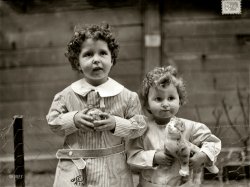
- Textbook Example: 1912
- Circa 1912. "New York Public Library building." With a variety of motorized ... Good Year I'm always on the lookout for photos taken in 1912, because that's the year that my Mom was born. She's 102 years old, and ... changed a bit, except I did notice that the facade in the 1912 views must have been unfinished, for today, 6 statues grace the frieze on ... Posted by Dave - 06/10/2014 - 10:06am -
![Textbook Example: 1912 Circa 1912. "New York Public Library building." With a variety of motorized conveyances. 8x10 glass negative, Detroit Publishing Co. View full size.
Libraries and carriagesI wonder if 100 years from now, whether Shorpy will display a similar photo that shows how libraries became as obsolete as horse-drawn carriages?
Will e-books have the same effect on these magnificent edifices as the internal combustion engine had on the carriages?
Hold On To Your HatThe building at the extreme left in this photo is still with us today. It was known as the Knox Hat Building, standing at 452 5th Avenue, it was built in 1902 as the headquarters of one of the Country's largest and most famous headgear manufacturers. A surrounding high rise glass tower was added when it was known as the Republic Bank Building. The major tenant and new owner is now another bank, HSBC.
He kindly stopped for meIn the bottom right corner of the photo there is a wagon hurrying along. Is that a coffin in the back?
[Whooooo knows? -tterrace]
Knox HatsWhile so much has changed in the past 102 years, one survivor in addition to the library itself is the building at the extreme left. Built in 1902 in the Beaux-Arts style, and designed by the same architect as Grant's Tomb, it was the headquarters of the Knox Hat Company for many years (Knox also had a huge factory in Brooklyn)and is still known as the Knox Hat Building even though the company's long gone. HSBC Bank now uses it for offices and has an enormous highrise building crowding it on two sides.
Library Lions"Fortitude" on the left, north side; "Patience" on the right, south side.
http://www.nypl.org/help/about-nypl/library-lions
A Very Good YearI'm always on the lookout for photos taken in 1912, because that's the year that my Mom was born. She's 102 years old, and still lives on her own and is sharp as a tack. When I see a photo like this, I try to imagine all of the things she has seen in her lifetime, and it helps me visualize the work into which she was born.
The New York Public Library has hardly changed a bit, except I did notice that the facade in the 1912 views must have been unfinished, for today, 6 statues grace the frieze on the colonnade, rather than the single one that was there then.
(The Gallery, Cars, Trucks, Buses, DPC, NYC)](https://www.shorpy.com/files/images/SHORPY-4a24384a.thumbnail.jpg)
- Owana at Toledo: 1912
- Toledo, Ohio, circa 1912. "Steamer Owana ready to leave for Detroit." 8x10 inch dry plate glass ... , most likely from the same day, at Smoke and Mirrors: 1912 .
Other vessels on Shorpy built at same Wyandotte shipyard:
... , 1907.
Sidewheeler City of Detroit III , 1912.
Sidewheeler Seeandbee , 1912.
Cresceus ... A Plaster ... Posted by Dave - 10/29/2012 - 10:42pm -
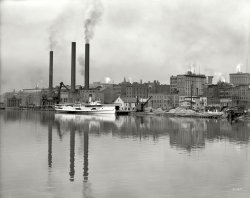
- Trashscape: 1912
- November 1912. "For Child Welfare Exhibit 1912-13. Whitman Street dump, Pawtucket, Rhode Island." Photograph by Lewis ... who labored through two years of organic chemistry. Circa 1912 plastics would include bakelite, celluloid, pyralin etc. - Dave]
... Posted by Dave - 11/05/2008 - 10:13pm -
![Trashscape: 1912 November 1912. "For Child Welfare Exhibit 1912-13. Whitman Street dump, Pawtucket, Rhode Island." Photograph by Lewis Wickes Hine. View full size.
ShantytownDo you suppose there were people living in what appear to be shanties in the middle ground on the right?
Slim Pickin'sNot much there, but I'd still love to go back in time and paw through the drifts of stuff.
Now?You have to wonder what's sitting on top of that time capsule these days.
One thing you won't find in that dump:Plastic. Plastic bags. Any variety of inorganic disposable crap.
[Chemically speaking, most plastics are organic, not inorganic. I say this as someone who labored through two years of organic chemistry. Circa 1912 plastics would include bakelite, celluloid, pyralin etc. - Dave]
ShedletsI don't think those little buildings are for people to live in. With windows that extensive, they would have been very poor in either heat or cold. But I do find it odd that the colonial style windows are so nicely made in comparison to the shacks themselves. Wonder if they were used as greenhouses, or as some kind of chicken coop (although the windows kind of rule out the coop concept as well). They definitely look to be constructed for special use of one kind or another.
Recycled windowsMy grandfather used old windows to make greenhouses, they always worked really well. The ultimate recycling.
Whitman Street TodayWhitman Street is about six blocks long, mostly residential with an elementary school.
View Larger Map
(The Gallery, Lewis Hine)](https://www.shorpy.com/files/images/02725u.thumbnail.jpg)
- Corps de Ballet: 1912
- "Photos taken during noon hour, October 23rd, 1912, at the Loray Mills, Gastonia, N.C. They said they were working and went ... are NOT ballet shoes and I am certain that, even back in 1912, no boy would be caught dead in his sister's ballet shoes!
They're ... Posted by Dave - 07/22/2012 - 12:44pm -
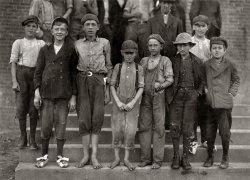
- Champ for President: 1912
- ... at the Democratic nominating convention in Baltimore, June 1912. View full size. 5x7 glass negative, George Grantham Bain Collection. ... there were a few states that allowed women the vote in 1912 - Wyoming Territory allowed women to vote in 1869 and Utah gave them the ... Posted by Dave - 09/09/2011 - 2:00pm -
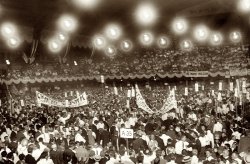
- White House Hotel: 1912
- October 15, 1912. "White House Hotel." The building at 156 Canal Street, New York, where ... Posted by Dave - 09/11/2011 - 8:31pm -
![White House Hotel: 1912 October 15, 1912. "White House Hotel." The building at 156 Canal Street, New York, where John F. Schrank lived prior to his attempted assassination of Teddy Roosevelt the day before. Bain Collection glass negative. View full size.
John F. Schrank, landlordAccording to the ever-trustworthy Wikipedia: "His parents died soon after, and Schrank came to work for his uncle, a New York tavern owner and landlord. Upon their deaths, Schrank's aunt and uncle left him these valuable properties, from which it was expected he could live a quiet and peaceful life."
So I assume that he didn't mere live at the White House Hotel, he owned and operated the hotel and the tavern.
[Not quite. Schrank rented a $2 room at the White House. The tenement he inherited was at 433 East 81st Street; the saloon he ran was at 370 East 10th Street. - Dave]
My kind of placeI like a hotel where you enter through the bar.
It all fits.This looks like exactly the kind of place an early 20th century assassin would hole up in!
Hotel entranceThere's a separate doorway to the left of the bar with "Hotel Entrance" lettered on the glass above it. A similar one on the right is the entrance to the sign shop.
I could be wrong, but this looks like the Jewish part of town.
Canal StreetI don't think it was a a Jewish neighborhood but a commercial street and many of the merchants were Jewish. Today it's Chinatown, Jake.
Hmm.I wonder what sort of business N. Shapiro was in.
The White HouseThe replication of the Presidential Seal on the top of the building is interesting. Pretty fancy for that neighborhood. But then, it is The White House.
Canal Street To-DayChinatown, indeed!
View Larger Map
Architectural LossesThe contribution by the Anonymous Tipster of "Canal Street Today" strikes a sad note in my heart to see the architectural loss of the facade of the old White House Hotel. While the neighboring buildings have mostly retained their character (cornice and windows), the facade of the White House Hotel has been stripped to complete sterile bareness. Undoubtedly, this reflects the priorities of the renovations over the years: the original opulent Second Empire styling would certainly have been expensive to maintain. Nonetheless, the Now-Then comparison is a worthy example of the need for historical preservation districts, IMHO.
Slice of heavenWow, a real slice of Americana!
+97Below is the identical view from May of 2009. Many of these buildings' neighbors were razed for the Manhattan Bridge, which begins one block to the east.
(The Gallery, G.G. Bain, NYC)](https://www.shorpy.com/files/images/10876u.thumbnail.jpg)
- $1.50 a Day: 1912
- May 1912. Rock Hill, South Carolina. "J.A. Leazer, a 19-year-old weaver at Highland ... with his wife Mamie (Mary J.) Collins and daughter Ruby (1912 - 5 Sep 1921).
Highland Park Mill I'd be interested in knowing ... Posted by Dave - 06/05/2008 - 4:36pm -
![$1.50 a Day: 1912 May 1912. Rock Hill, South Carolina. "J.A. Leazer, a 19-year-old weaver at Highland Park Mill, and his family. Began working at 9 years old. Makes $1.50 a day now and says he probably can't get any more as a weaver. Many of them marry young." View full size. Photo and caption by Lewis Wickes Hine.
James Arthur LeazerMost probably James Arthur Leazer, son of David Leazer and Melinda Atkins, born 17 May 1893 and died 12 Apr 1973; widowed.
Pictured with his wife Mamie (Mary J.) Collins and daughter Ruby (1912 - 5 Sep 1921).
Highland Park MillI'd be interested in knowing where this image was obtained. Both of my great grandparents, and all their siblings worked at that Mill. I'd love to know if there was a possibility of more images that might include them.
[Library of Congress Prints & Photographs Division Online Catalog. There are six Highland Park Mill photos. - Dave]
RubyWhy did Ruby die at aged 9? Such a young age to go!
J.A. Leazer, $1.50 a DayThis is Joe Manning, of the Lewis Hine Project. I just talked to a niece and nephew of James Arthur Leazer. They were very surprised about the photo. I will be interviewing the niece soon. Thanks to the previous comment for starting the ball rolling on this.
James LeazerThis is Joe Manning, of the Lewis Hine Project. I have completed my research on this picture, and it is a sad and strange story. Despite the appearance of being an earnest young couple, the Leazers were headed for trouble when Hine encountered them. I interviewed one of their sons, and a niece. You can see the full story at:
http://www.morningsonmaplestreet.com/jamesleazer1.html
Ain't No Happiness ThereWell I must say, despite Joe Manning's description of this picture appearing to depict an earnest young couple, there's nothing in the body language or facial expressions above that denotes any kind of happiness or warmth. Much less love.
They're both looking down sullenly at that baby like "What the hell is this?" He's turned away from his wife, bothering to turn only his head in her direction, as if they were strangers and she just that moment sat down next to him and interrupted his train of thought. She looks tired and a bit tense and is leaning away from the baby, as if unsure how to proceed. Clearly a baby is still an alien object to her.
James LeazerJoe Manning again. The previous comment by Nicholas West is very insightful. I thought they might just be uncomfortable with the camera, and given their ages, not very sure about what to do with the baby. But given what happened to them, I guess Mr. West's observations are right on the money. Thanks, Nicholas.
(The Gallery, Kids, Lewis Hine)](https://www.shorpy.com/files/images/02537u.thumbnail.jpg)
- Plaza Hotel: 1912
- New York circa 1912. "Plaza Hotel, Fifth Avenue at 59th Street." The original "big box." 5x7 ... Posted by Dave - 03/04/2013 - 10:09am -
![Plaza Hotel: 1912 New York circa 1912. "Plaza Hotel, Fifth Avenue at 59th Street." The original "big box." 5x7 glass negative, Detroit Publishing Company. View full size.
High End DigsThe Plaza Hotel, built in 1907, is now a condominium as well. There are listings for 3 bedroom apartments, 2 are available, one at $11,995,000 and the other $14,750,000. If a 3 bedroom won't work for you there are 2 4BR units offered for $25,000,000 and $55,000,000, respectively The prices are negotiable and pets are allowed.
Big Box IndeedRemarkably large and unattractive. Wonder if the filigree on top prompted the first usage of "lipstick on a pig?"
EloiseAny mention of the Plaza Hotel to a native New Yorker immediately conjurs up remembrances of it's most famous "guest" Eloise, even though she never actually stayed there.
Before the hotel became condos, they held an auction at which almost every item from the original hotel (from furniture to doorknobs) were sold at unbelievable prices. Eloise kind of disappeared during the renovations, but just made her grand re-entrance.
Welcome Home, Eloise !
Unattractive?I think it shows a magnificence that no longer is ever built.
What is it about Shorpy photos?The sheer size, massiveness and height of this amazing building is eye-popping. What IS it about so many DPC photos, which seem much more grand, especially compared to the street maps we compare with today? Those DPC photogs had an amazing eye for their work.
Yes, it's just a big block-long-and-wide square, but the architects at least topped it off in an interesting way, giving it an incredible grandeur.
I'd pay a tidy sum for a chance to put up the flags up there any morning, or to look out over NYC from one of those turrets.
Well, the awnings have gone -- and there are fewer horses.
View Larger Map
Sic TransitAnd now it's partly condos, and not an awning to be seen ... better than ending up like Penn Station, however.
Glorious BuildingHere's to another 100 years, plus! What changes will it see by then.
Main EntranceThese days the main entrance is on the Fifth Avenue side, through the porch with the six white columns. There is still a door facing Central Park South, where the big marquee is in this pic, but I don't think it even has a taxi rank anymore. I guess it keeps the traffic flowing better.
John, Paul, George, and RingoThe Beatles camped out at the Plaza during their first collective visit to America in February 1964. George was laid up in the room with a bad cold on Feb. 8, whilst the other lads went larking about Central Park. By the evening of Sunday the 9th, George recuperated well enough to take the stage with the others on the Ed Sullivan Show. The rest you already know.
Stepping out?Looks like someone is stepping out backwards. Left corner turret, top floor. Hope I'm wrong.
[Looks like you're right. Eek. - tterrace]
Pre "Health and Safety"Well spotted ProMagnon, but I'm fairly sure he's cleaning the window. His belt might be fixed to an anchor point inside, but somehow I doubt it.
(The Gallery, DPC, NYC)](https://www.shorpy.com/files/images/SHORPY_4a27612a1.thumbnail.jpg)
- Tashmoo Plus Two: 1912
- Detroit, Michigan, circa 1912. "Daily river excursion steamers. Sidewheelers Tashmoo , Owana and ... Posted by Dave - 08/14/2012 - 5:09pm -
![Tashmoo Plus Two: 1912 Detroit, Michigan, circa 1912. "Daily river excursion steamers. Sidewheelers Tashmoo, Owana and City of Detroit III at White Star Line dock." 8x10 inch dry plate glass negative, Detroit Publishing Company. View full size.
Thanks Gramps!My Grandpa painted ships in Detroit, I have a beautiful oil painting of the Tashmoo hanging on my wall that he did a few years before he died.
StudebakerIs the name on the crating on the machine goods "Studebaker Corporation"?
[It is. - Dave]
Sorry, honeyCouldn't get the money to take the cruise.
Paul SeniorMy gosh, if it isn't Paul Teutul Sr., of Orange County Choppers!
I see you.Same to ya, buddy!
And on the top deckis the dutiful U-boat spotter.
On the dockThose have to be the flimsiest shipping crates I've ever seen.
Barrels of bottles!Looks like someone remembered to put the glass recycling out! Hope that isn't all beer !
99 bottles of everything.From the number of empties on the lower left, it looks as if these were not dry cruises.
The Glass HackThis was the nickname given the Tashmoo. She had over 600 windows. She was a day steamer that sailed from Detroit every morning in the summer with a stop at Tashmoo Park to disembark picnickers. She continued to Port Huron with a short stop, crossed over to Sarnia headed back to Harsons Island to pick up the people after a outing at the park, returning to Detroit in the evening.
Built in 1901, she sank at Amherstburg, Ontario, in 1936 and was cut up for scrap.
(The Gallery, Boats & Bridges, Detroit Photos, DPC)](https://www.shorpy.com/files/images/4a25488a1.thumbnail.jpg)
- Peoples Gas Light & Coke: 1912
- Chicago circa 1912. "Peoples Gas Company Building, Michigan Avenue." 8x10 inch dry plate ... top but they left the bric-a-brac that was at the top in 1912 as part of the newer facade.
[Both of those smaller buildings have ... Posted by Dave - 01/07/2021 - 3:08pm -
![Peoples Gas Light & Coke: 1912 Chicago circa 1912. "Peoples Gas Company Building, Michigan Avenue." 8x10 inch dry plate glass negative, Detroit Publishing Company. View full size.
+105Below is the same view from June of 2017.
Horse of a different colorEither the gas company did an architecturally sensitive addition, or the difference in color on the front of the building indicates that it is undergoing a much-needed cleaning.
[It was built in two phases. - Dave]
If a cake were a buildingAcross the street from the Art Institute. Luscious architecture. There's a Walgreens in the ground floor where I bought a Coke on a scorching day in August of 2018 after a visit to the galleries.
The TrioI'm surprised that the two smaller buildings to the right are still there. The one farthest to the right has some more floors added on top but they left the bric-a-brac that was at the top in 1912 as part of the newer facade.
[Both of those smaller buildings have had floors added. - Dave]
The Missing CorniceThis photograph shows the exuberant original cornice that once crowned this building - now sadly truncated, as seen in the contemporary photo. Persistent rumors tell of a municipal ordinance that required building owners to remove projecting cornices from downtown Chicago buildings sometime in the late 1940s. The Chicago History Museum collection has a picture of this operation being performed on the Marshall Field Department Store dated November 25, 1947. While some notable Chicago landmarks (the Reliance Building, the Carson Pirie Scott Store) have had their cornices restored in facsimile form in recent years, this one and so many others are still sadly shorn off at the top. What a terrible shame!
[If you want your noggin bashed in by falling masonry. - Dave]
2017 ImageThat is a beautiful photo, Timeandagainphoto.
Re: 2017 ImageThank you very much Sayles.
(The Gallery, Chicago, DPC)](https://www.shorpy.com/files/images/SHORPY-4a19982a.thumbnail.jpg)
- Three Skyscrapers: 1912
- New York circa 1912. "Manhattan skyline from Brooklyn." The Singer Building rises at left ... Posted by Dave - 07/18/2012 - 6:59pm -
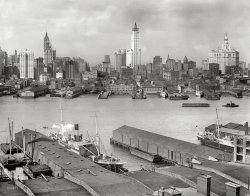
- In Good Hands: 1912
- "Boy Scout Training demonstration, 1912." Yes, they're back. I found a few more of these oddly poignant portraits ... Posted by Dave - 08/15/2012 - 5:50pm -
![In Good Hands: 1912 "Boy Scout Training demonstration, 1912." Yes, they're back. I found a few more of these oddly poignant portraits of Scouting first aid to the injured. Harris & Ewing Collection glass negative. View full size.
ZZZZZZZZZZZ !GAWD! Enough boring, pointless Boy Scout pictures already.
Kerry CreepyThe guy on the left has an uncanny resemblance to Senator John Kerry. Kinda creepy, if you ask me.
Ignore the doubtersDave, ignore the doubters ... I like these old scouting pictures. I learned this same carry when I was a scout. Maybe one of these days, I'll print these out and show them to some of the boys in my troop.
Don't Stop Bring Em' OnPut up all the damn pics you want, whatever they are, boy scout or not...
They are all just terrific
Prelude to WarI wonder how many of these Scouts had to use their "rescue-the-wounded" skills a few years later in The Great War. These pics are kind of a creepy Prelude to War.
Another great addition to this seriesKeep them coming, I say!
More scouts please!And I'd love to see some Girl Scout ones too, if possible.
Wow, I missed thatWow, I missed that comparison of what you start with and what you finish with when it was originally posted. Amazing! You do good work. Thanks for that.
BSA! BSA!Given a choice between downtrodden piece workers in New York tenements and Boy scouts learning valuable life skills 100 years ago. I have to add another vote for the BSA pictures. Keep em coming.
BadI can't believe you are actually putting that SHORPY logo on pictures that are not yours. It's just pathetic.
[What's pathetic (or at least moderately annoying) is ignorance. The jpegs on this site are indeed ours. More here. - Dave]
Thanks DaveI love all the pictures that you put up. In each and everyone I find amazing details. Like what is that hanging off the boy to the lefts belt? Plus as someone who does a lot of Photoshop, thank you for taking the time to clean these pictures up. I know that when I do similar work, it take time and a bit of finesse.
[You're very welcome. - Dave]
Wonder if he has a single great-grandson...The Scout on the right is a handsome devil. He has kind of a young Warren Beatty thing going on.
(The Gallery, Boy Scouts, Harris + Ewing)](https://www.shorpy.com/files/images/00693a.thumbnail.jpg)
- Detroit Deli: 1912
- Detroit, Michigan, circa 1912. " Edelweiss Cafe , delicatessen room." 8x10 inch dry plate glass ... Posted by Dave - 07/04/2011 - 2:14pm -
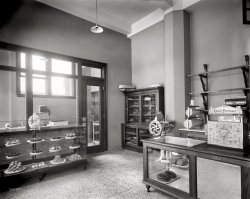
- National City Bank: 1912
- New York circa 1912. "National City Bank, Wall Street at William Street." Also the Atlantic ... Posted by Dave - 04/18/2022 - 4:13pm -
![National City Bank: 1912 New York circa 1912. "National City Bank, Wall Street at William Street." Also the Atlantic Building, and a sliver of U.S. Trust. Detroit Publishing Company glass negative. View full size.
Piggy-back... if not "piggy bank". They don't build 'em like this anymore (actually, they didn't even build 'em like this then: the upper floors were a later addition.)
From U.S. Custom House > Bank HQ > Luxury Hotel > Condos: all while its cousins in other cities were consigned to the landfill in their youth ... some buildings have all the luck !!
110 years laterIt's a scarier world on Wall Street; here and look to your right.
The Merchants' ExchangeThis building has an extraordinary architectural history. It was built in 1836-1841 as the Merchants' Exchange, designed by architect Isaiah Rogers from Boston. The original building consisted of only the lower three stories, with the Ionic colonnade, and a big dome in the center of the block. As such, it was clearly modeled after Karl Friedrich Schinkel's Altes Museum in Berlin, built 1822-1828. From 1862 on it served as the US Custom House, which had been housed in what is now called the Federal Hall National Memorial (aka the Subtreasury) at Wall Street and Nassau Street. When the Custom House moved out to occupy Cass Gilbert's Beaux-Arts extravaganza facing Bowling Green, the National City Bank bought the building and hired McKim, Mead and White to expand it (1907-1910). Charles F. McKim decided to double the building in height by adding four more stories with a Corinthian colonnade on top of the original Ionic structure, while creating an entirely new interior with an impressive domed banking hall at the center. He integrated his addition so well that you would hardly suspect it was ever added in the first place!
One pieceThe Bank building with its formidable pillars began life as the Merchants Exchange building. Those pillars came down the Hudson River -- and are one piece of stone -- no joints.
[There are joints in the upper columns. - Dave]
Melville's neighborhoodHerman Melville worked as a customs inspector in New York from 1866 to 1885. His work was around the wharves, and inspectors had to rent their own work space nearby. But he would have been in and out of this Custom House over two decades.
Melville was paid four dollars a day for a six-day work week. He never received a promotion or a raise in pay.
(The Gallery, DPC, NYC)](https://www.shorpy.com/files/images/SHORPY-4a25611a1.thumbnail.jpg)
- Ready or Not: 1912
- ... pillars" at the Overbrook School in Philadelphia ca. 1912. View full size. Geo. Grantham Bain Collection.
Overbrook This ... Posted by Dave - 09/08/2011 - 12:19pm -
![Ready or Not: 1912 "Blind children playing hide-and-seek among arcade pillars" at the Overbrook School in Philadelphia ca. 1912. View full size. Geo. Grantham Bain Collection.
OverbrookThis school for the blind is still up and running here is a link:
http://www.obs.org/page.php?ITEM=150
Overbrook IIhttp://www.obs.org/photoblog/?p=20
You can't hide broccoli in a glass of milk
Overbrook tableauSurreal! Giorgio de Chirico meets Edward Gorey ...
Overbrook: the AlbumWhat a beautiful picture. I could see this on the cover of a CD.
Reminds Me Of An Escher Woodcut
IcoLooks like the cover art for the game ICO. Scarily close, actually.
[That cover art (below) is a tribute the the art of Giorgio de Chirico. Which might be where the name Ico comes from. - Dave]
(The Gallery, Education, Schools, G.G. Bain, Kids, Philadelphia)](https://www.shorpy.com/files/images/03972u.thumbnail.jpg)
- The Big P.O.: 1912
- Detroit, Michigan, circa 1912. "Detroit Post Office." Behold the sooty Motor City. 8x10 inch dry plate ... Posted by Dave - 05/01/2013 - 12:21pm -
![The Big P.O.: 1912 Detroit, Michigan, circa 1912. "Detroit Post Office." Behold the sooty Motor City. 8x10 inch dry plate glass negative, Detroit Publishing Company. View full size.
Stripes What sort of flag is flying above the entrance?
I want that roomwith the awning at the front on the top right.
Flag IDIt's the flag of the US Customs Service.
Flag flying over the entrance.Q: What sort of flag is flying above the entrance?
A: The flag with the vertical stripes atop the right face of the building in the image is the United States Customs Service Flag. Just a brief ferry ride from Detroit, across the Detroit River, is Windsor, Ontario.
Flag above the entranceRevenue Cutter Service Flag.
The flaglooks like the US Customs ensign.
Name that FlagThe flag belongs to the (former) United States Customs Service, which was the primary tax-collecting agency of the Federal Government before advent of the personal income tax. Items imported into the country were charged duty, hence the location of the agency in a post office.
A color illustration of the flag can be found at Wikipedia.
More Than It SeemsAlthough it was called the "Post Office Building" by a couple of generations of Detroiters, this was really the Federal Building for the Detroit area, and contained the local offices of several federal agencies and the federal courthouse. It was torn down in 1931 to make way for a new WPA-era Federal Building on the same site. That very nice art deco structure is still in use today.
I believe the flag over the entrance is that of the U.S. Customs Service. Detroit has long had a significant Customs presence, as it is the busiest port of entry from Canada.
Mystery of the Forgotten FlagThe flag on the post office is an emblem of the past and was known as the Civil Flag. The flag originated with the Sons of Liberty in the American Revolution when they turned the flag of the British East India Company sideways to show they were sovereign from the rule of England.
Oliver Wolcott was responsible for the design of the flag seen flying over the post office in the photo. It consisted of 16 stripes, one for each state of the Union as of the flags design on June 1, 1799, and the totemic emblem of the US, the eagle. It became known as the Customs Flag, and was used to distinguish the non-military operation of US Customs.
More here.
[Someone there could use a refresher on the difference between "its" and "it's." - Dave]
Re: StripesDepending on the specific year the photo was taken, it is either the ensign of the U.S. Revenue Cutter Service or the U.S. Coast Guard (the U.S. Revenue Cutter Service merged with the U.S. Lifesaving Service in 1915 to form the U.S. Coast Guard). Prior to the explosive growth of the federal government, federal agencies and offices were housed in Post Office buildings (since the Post Office was actually authorized to have a presence in states by the Constitution whereas other federal authorities were not - see the 10th Amendment).
Architectural JazzGee, that building has a bit of everything in it, from the basic to the complicated. The architect must have been wanting to make a name for himself.
Those gargoylish ardornments protruding from each corner of the tower just above the clock faces are awesome. I just hope the Motor City isn't prone to earthquakes.
(The Gallery, Detroit Photos, DPC, Streetcars)](https://www.shorpy.com/files/images/4a25486a.thumbnail.jpg)
- Palm Gardens: 1912
- Miami circa 1912. "Car'Dale Tower and landing, head of navigation, Miami River." At left, ... shadows over there is already practically an antique in 1912. I see a snub nose and a tiller...this is a horseless carriage of some ... Posted by Dave - 10/26/2015 - 10:24pm -
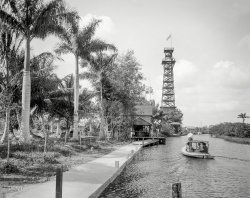
- Government Printing Office: 1912
- Washington, D.C., 1912. "Government Printing Office -- views." The G.P.O. a century ago. Harris ... Posted by Dave - 08/10/2012 - 12:20am -
![Government Printing Office: 1912 Washington, D.C., 1912. "Government Printing Office -- views." The G.P.O. a century ago. Harris & Ewing Collection glass negative. View full size.
Bureaucratic food chainA bunch of guys who make government forms and one of the guys who use them.
Who picks up the trash?They may have a very nice wastebasket next to the second press, but they sure don't seem motivated to use it.
Basket empty. Floor full.
Dress CodeOnly one guy with no tie, or even a collar. And a mustache, too. He looks like the last guy in the shop you'd mess with. Meanwhile, everyone else has to wear a tie and keep it tucked in, or risk strangulation.
What a mess!This is one of the most unkempt work places that I have seen on Shorpy. Scraps of paper and empty boxes scattered all over the floor.
Really Gets into His WorkThat fellow in the front must really love his job. He's got ink all over him, including his nice white tie!
JobsThis looks like a much better choice for jobs than coal miner.
Can we say underage employee?Several of those "young men" look exceptionally young, i.e., 16 or under. But the kid in front, far right is still in kneepants. One thing I've learned from perusing Shorpy is that boys didn't wear long pants until they reached puberty. So - that makes this kid 12, 13, 14 maybe? Guess the Gov't didn't concern itself with such minutiae back then.
[They're office boys, a.k.a. clerks, gofers, interns. - Dave]
Um, I think I'm in the wrong office.A stern looking crew here.
Got broom? This office has not been 5S'ed in a loooong time.
Messy Work Place? - JellyBelly JellyBelly .. You must have missed this mess.. https://www.shorpy.com/node/5561 which I do believe is the messy-ist work place Mess on Shorpy
Rats in the AlleywayMy maternal grandfather was born in Washington, D.C. He took great pride in the fact that he was born on Flag Day in 1903. His father died at an early age leaving his wife to raise 4 young boys. She enjoyed quite a social life so her sons learned very quickly how to fend for themselves. Like rats scurrying the District's alleyways they, too, scrapped for food. The bakery was a favorite because of the stale donuts and heels of bread tossed at the end of the day. And so, as the story goes, my grandfather began sweeping floors at Merkle Press. The business owner saw potential in Joseph Howard Johnson, Sr. His hard work and perseverance did not go unnoticed by Mr. Merkle. He thought it worth his time and effort educating my grandfather with every aspect of the printing trade. My grandfather retired 47 years later with a gold watch, golf clubs and a legacy like none other.
(The Gallery, D.C., Harris + Ewing)](https://www.shorpy.com/files/images/SHORPY_01685a.thumbnail.jpg)
- Fifth Avenue: 1912
- New York circa 1912. "Fifth Avenue at 42nd Street." At left, the East Coast outlet of ... many pedestrians were lost on the streets of New York in 1912?
Street Clock at 522 Fifth Ave. Still standing!
Great ... Posted by Dave - 07/10/2018 - 7:58pm -
![Fifth Avenue: 1912 New York circa 1912. "Fifth Avenue at 42nd Street." At left, the East Coast outlet of California's Cawston Ostrich Farm. 5x7 inch glass negative. View full size.
Driving rightI know we've always stayed to the right in the US when traveling down a road, but I wonder when the driving position within the vehicle shifted to the left side? All the drivers in the photo are sitting on the right hand side of their vehicles.
[There was a gradual transition from a mix of left- and right-hand drive cars. By 1920 they were almost all LHD. - Dave]
More dangerous than the TitanicI wonder how many pedestrians were lost on the streets of New York in 1912?
Street Clock at 522 Fifth Ave.Still standing!
Great old time outfits.As long as you like Black.
Early movie of 1911 New York CityIn this speed-corrected early movie with sound added of New York City in 1911, it's amazing how these first people in human history to have access to self-propelled vehicles seem to have so quickly adapted to them without benefit of any rules or traffic lights, both pedestrians and drivers--it's almost like we had some kind of hard-wired affinity for the advent of the automobile. Of course, skill sets in other areas no doubt helped.
https://www.youtube.com/watch?v=aohXOpKtns0
Men in WhiteThe vehicle in the middle of the street heading away from the photographer appears to have a police officer and a Good Humor man in back. Any ideas as to what the vehicle would be used as? Paddy wagon, ambulance or ice cream truck?
[The white suits on New York's streets in photos from this era are generally sweepers with the Department of Sanitation. - Dave]
You couldn't pay me enoughNo sirree, not me. Those two gents in the upper left working
on the sign need hazardous duty pay.
(The Gallery, Cars, Trucks, Buses, DPC, NYC, Stores & Markets)](https://www.shorpy.com/files/images/SHORPY-4a27524a.thumbnail.jpg)























